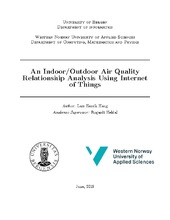An Indoor/Outdoor Air Quality Relationship Analysis Using Internet of Things
Master thesis
Permanent lenke
https://hdl.handle.net/1956/20862Utgivelsesdato
2019-06-29Metadata
Vis full innførselSamlinger
Sammendrag
Exposure to high levels of air pollution is a significant cause of premature mortality. In Norway, people spend about 90% of their time indoors. Therefore, the relationship between indoor and outdoor concentrations of air pollution is important for the understanding of potential health effects from pollution. In addition, the indoor climate plays a critical role in the comfort of building occupants. Niche companies, with heavy-duty analyzers can be used to monitor the air quality in buildings. However, low powered and cheap IoT-devices with a long communication range offer the potential for more continuous monitoring and analysis of buildings air quality, while covering a larger geographical area. In this research, we present an air quality monitoring system, based on a LoRaWAN network with low cost sensors. The dashboard web application includes all features needed to help increase air quality awareness in buildings. We analyze the relationship between indoor and outdoor air quality in different building types (office, campus, and residential), and investigate the difference between old and new buildings. We measured the concentrations of indoor and outdoor particulate matter (PM2.5 and PM10), carbon dioxide (CO2), temperature, and humidity at six different buildings in Bergen, Norway. The results show that the overall air quality in the monitored buildings are within the set climate recommendations. In addition, our results indicate that there is a stronger relationship between indoor air quality and outdoor pollution in old mechanically ventilated buildings.
